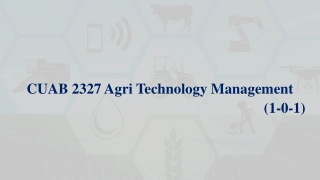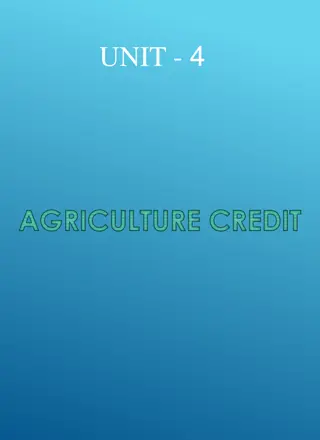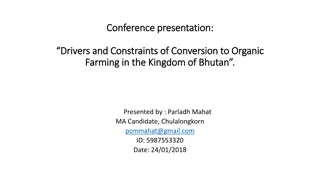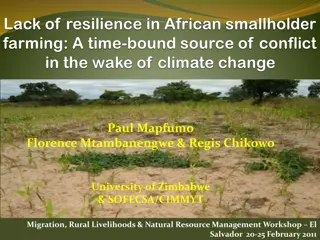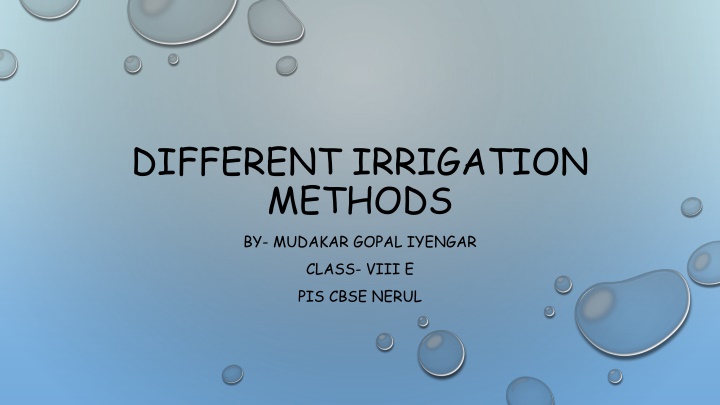
Exploring Modern Irrigation Methods for Sustainable Agriculture
Discover the innovative irrigation methods discussed by Mudakar Gopal Iyengar in his class VIII project at CBSE Nerul. The spotlight is on the groundbreaking Ramthal Drip Irrigation Project in Karnataka, the largest of its kind globally. Delve into the benefits of drip and sprinkler systems, as well as the concept of sustainable irrigation practices for the future of agriculture.
Uploaded on | 1 Views
Download Presentation

Please find below an Image/Link to download the presentation.
The content on the website is provided AS IS for your information and personal use only. It may not be sold, licensed, or shared on other websites without obtaining consent from the author. If you encounter any issues during the download, it is possible that the publisher has removed the file from their server.
You are allowed to download the files provided on this website for personal or commercial use, subject to the condition that they are used lawfully. All files are the property of their respective owners.
The content on the website is provided AS IS for your information and personal use only. It may not be sold, licensed, or shared on other websites without obtaining consent from the author.
E N D
Presentation Transcript
DIFFERENT IRRIGATION METHODS BY- MUDAKAR GOPAL IYENGAR CLASS- VIII E PIS CBSE NERUL
RAMTHAL DRIP IRRIGATION PROJECT The Ramthal drip irrigation project in Karnataka is the largest single drip irrigation project in the world. The 60,000 acre project is divided into divisions which are further divided into sub- divisions. Many farmers are benefitted by this, as there was lack of available water, and now due to this drip system project, water is conserved. The water for irrigation is brought from the Krishna river through pipes.
WHY I CHOSE THIS PROJECT? The Ramthal success in irrigation in a dry zone prompted me to find out How do these new methods help in having a sustainable model of irrigation in agriculture. There are mainly two such types of irrigation: Drip System (as seen in Ramthal) Sprinkler system Let s look at how they work and compare them to the traditional methods of irrigation.
DRIP IRRIGATION In this method, pipes are attached to a tank or reservoir. These pipes have small tubes called emitters at equal intervals. When water is supplied through the emitters, it falls drop by drop onto the soil near the root zone of the plants. This method is very useful to water fruit trees in orchards. A lot of water is saved as it is not lost through evaporation or percolation. This method is very effective in areas with low water availability as there is no wastage.
SPRINKLER SYSTEM Sprinkler system is a method of irrigation which is similar to rainfall. In this system vertical pipes are fitted to a main pipeline on equal distances. Each vertical pipe has a nozzle called sprinkler on top. Water flows into the vertical pipes from the main pipeline with the help of pumps. Water is pumped into the nozzles under pressure which sprinkles it all over the field. This method is effective in irrigating sandy regions and regions with uneven land which have insufficient water supply.
SUSTAINABLE IRRIGATION Sustainable irrigation is the rational practice of all activities related with the irrigation of plants, whether in the areas of agriculture, landscape and ornamentals, so that it helps satisfying the respective survival and welfare needs of the present without compromising those of future generations.
FURROW IRRIGATION In this system, furrows are made in the field. Water is brought to the field by a canal which is part of either the dhekli, rahat, chain pump or moat system. The water is poured into the furrows. The water reaches the roots of the plants through the soil.
TRADITIONAL METHODS OF IRRIGATION RAHAT SYSTEM In this system, the Persian wheel which is dipped in the water is used. There are buckets attached to the wheel which collect water from the reservoir. There is lever which is rotated by bullocks and other such animals. When the lever is moved, the wheel rotates and the buckets get filled with water. The buckets are emptied into a canal which transports the water to the field.
DHEKLI SYSTEM In the dhekli system of irrigation, two logs of wood are used. One of them is Y- shaped. The other one is generally straight and has a bucket at one end and a counterweight at the other. The bucket is dipped in the well. Once water is collected in the bucket, it is poured into a canal which transports the water to the field.
CHAIN PUMP In this system, there are two gears joined by a chain. The larger one is placed beside the canal which carries water to the field. The smaller one is half under the water in the reservoir. There is crank on the larger gear which helps in moving the chain. There are two or more buckets attached to the chain. When the crank is rotated, the chain moves and the buckets collect water from the reservoir. The buckets hit an extrusion which is placed near the canal and the water is poured into it. The canal then transports the water to the field.
MOAT/ PULLEY SYSTEM In this system a pulley is used. There is well and above it, there is a pulley. A rope has a bucket is attached on one end and is pulled from the other end with the help of the pulley. The bucket is dipped in the well and water is collected. The water is poured into a canal, which transports the water to the field.
COMPARISON BETWEEN THE TRADITIONAL AND NEW SYSTEMS OF IRRIGATION SHOWS THAT.... There is a lot of unnecessary wastage of precious water in the traditional methods. As pointed out before, the new systems help conserve water by reducing evaporation and percolation. I have personally experienced the above when I lived in Qatar, which has an arid climate. Every drop counts....

